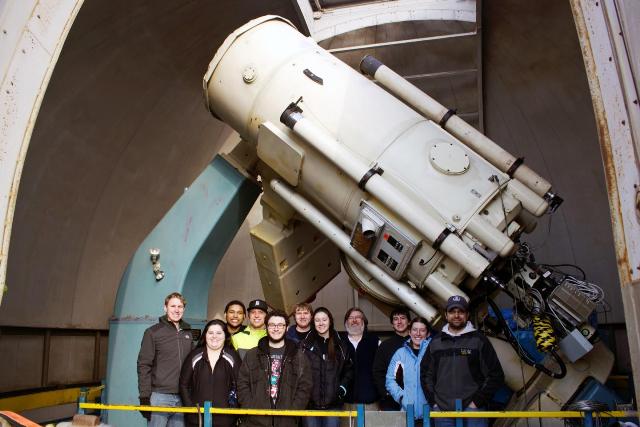Feb 9 2015
How do astronomers determine the shapes of objects that are too far away to photograph? One method is by using spectropolarimetry, an observational technique that measures the way light waves align after they scatter through clouds of gas and dust in space.
The Half-wave Spectropolarimeter (HPOL) is an instrument designed by Wisconsin astronomer Dr. Kenneth Nordsieck in 1989 to conduct these measurements. During HPOL's 15-year lifetime at the University of Wisconsin's Pine Bluff Observatory (PBO), astronomers worldwide used data from HPOL to study the gas and dust surrounding planets, comets, stars, and supernovae, as well as the interstellar medium within our Milky Way Galaxy.
 The University of Toledo observing team poses with the HPOL instrument (far right) mounted on the Ritter Observatory 1-m telescope. Graduate and undergraduate students in the Department of Physics & Astronomy conduct observations with HPOL every clear night. Credit: Kevin Hardegree-Ullman
The University of Toledo observing team poses with the HPOL instrument (far right) mounted on the Ritter Observatory 1-m telescope. Graduate and undergraduate students in the Department of Physics & Astronomy conduct observations with HPOL every clear night. Credit: Kevin Hardegree-Ullman
HPOL's specialty was variable stars, whose properties change over time because of eruptions, pulsations, or interactions with companions. Studying such objects requires monitoring them continuously over long periods of time. HPOL made this kind of monitoring possible with its dedicated and continuous operation at the 0.9-m PBO telescope outside Madison, WI. Unfortunately, it ceased operations at PBO in 2004 after several equipment failures.
In 2007, astronomers from the University of Wisconsin, the University of Toledo, the University of Denver, and the University of Oklahoma teamed up to bring HPOL out of retirement and move it to Toledo, OH. A Toledo group led by Dr. James Davidson, Dr. Karen Bjorkman, and Dr. Jon Bjorkman installed new components, upgraded the control software, and mounted HPOL on the 1-m telescope at the University of Toledo's Ritter Observatory. The consortium members then conducted an extensive study of the upgraded instrument's performance at its new location; their results appear in a recent issue of the Journal of Astronomical Instrumentation (Davidson et al. 2014, JAI, 03, 1450009). They obtained multiple observations of polarized standard stars using the new HPOL, which show excellent agreement with comparable observations made at PBO. In some cases the instrument achieves even smaller measurement uncertainties than it did before, despite a brighter sky in the more urban Toledo location.
"I'm delighted with the results from the new HPOL," said Dr. Jennifer Hoffman, an astronomer at the University of Denver, consortium member, and co-author on the JAI study. "Having this instrument available again opens up exciting new possibilities for astronomers who use spectropolarimetry, especially those of us who study variable or transient objects." The first new scientific results from the refurbished instrument were recently published in Astronomy & Astrophysics (Lomax et al. 2015, A&A, 573, A43). HPOL is now fully operational at Ritter Observatory; the consortium welcomes target suggestions from the astronomical community.